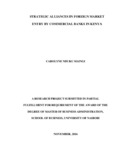| dc.description.abstract | Commercial banks are forced to form strategic alliances while entering foreign markets, or for that matter to continue servicing its current markets. In Kenya, the banking sector is a cut-throat business arena, with over 44 players among them are multinationals all scrambling for a slice of the market share. Ten of the 44 commercial banks in Kenya have operations in the foreign markets. The 10 banks account for a significant size of the Kenyan banking industry in terms of a composite market share index of net assets, total deposits, shareholders’ funds, number of loan accounts and number of deposit accounts. The research stream on strategic alliances in foreign market entry by commercial banks in Kenya is relatively novel and still under vivid scholarly debate. Ambiguity, vagueness of constructs, conflicting views, and lack of empirical data are still predominant and represent challenges to explaining successful strategic alliances in foreign market entry by Kenyan commercial banks to the rest of Sub-Saharan Africa. Against this backdrop, the study sought to establish the strategic alliances in foreign market entry by Kenyan commercial banks in Kenya. This study employed a descriptive and cross sectional research design. The target population in the study was the Kenyan commercial banks with foreign market operations. Primary data was collected using a quantitative approach. The research instrument was divided into two major sections, requiring responses to various dimensions based on the Likert type scale for purposes of enabling easy rating /ranking of answers, coding and data analysis; and a closing open ended section. The respondents were either of the two (2) business unit heads designated as CEOs or Senior Managers, general managers and functional heads from each of the banks who are responsible for day – to day operations of the strategic alliances and foreign market entry of the banks. The data collected was purely quantitative and it will be was analyzed by descriptive analysis. The descriptive statistical tools such as Statistical Package for Social Sciences (SPSS) and MS Excel helped the researcher to describe the data and determine the extent used. Data analysis used frequencies, percentages, means and other central tendencies. The Likert scales were used to analyze the mean score and standard deviation. The findings were presented using tables and charts. The study concludes that strategic alliances have become prevalent in order to strengthen the market positions and improve on performance of Kenyan banks in foreign markets. There has been a moderate level of adoption of strategic alliances in foreign market entry by Kenyan commercial banks. Accordingly, strategic alignment, partner matching and value creation affect the foreign market entry by commercial banks in Kenya to great extents, while coordination and appreciation affects the foreign market entry by commercial banks in Kenya to a moderate extent. Kenyan commercial banks should always strive to ensure that they increase the number of strategic alliances. Kenyan commercial banks should carry out research on prospective foreign markets to inform the choice of strategic alliances for foreign market entry. This is to ensure they use the appropriate entry strategy to enhance the organization performance. | en_US |



